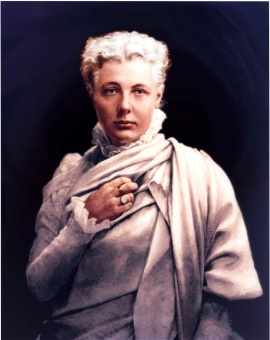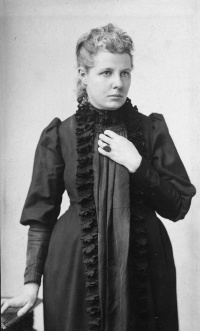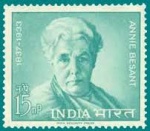Annie Besant

NOTE: THIS ARTICLE IS UNDER CONSTRUCTION
NOTE: THIS ARTICLE IS UNDER CONSTRUCTION
Early life and family
Early social activism
Introduction to Master Morya and Madame Blavatsky
Before she met Madame Blavatsky and joined the Theosophical Society, Annie Besant heard the voice of the Master Morya twice. The second of these instances occurred in 1889, when she was in her office. She was in despair because Truth seemed unattainable. She wrote:
I was making desperate efforts to pierce the darkness, and was seeking with passionate earnestness to obtain some direct evidence of the existence of Soul and of the superphysical worlds; one evening as I sat alone, concentrating my mind on this longing, I heard the Master's voice --- but knew not whose it was ---and after some questions asked by Him and answered by me, came the promise that I should soon find the light --- a promise quickly verified.[1]
The voice of the Master asked her "Are you willing to sacrifice everything to find Truth?", and she replied, "Yes, Lord". Then the voice continued: "You will find it soon." A fortnight passed and her friend, Mr. William Stead, the famous Editor of the Pall Mall Gazette, sent her the volumes of The Secret Doctrine to review. After feeling illuminated by the book, Annie saw the truth in it, and sent a note asking for an introduction to the writer.[2]
In July 1889, after meeting Mme. Blavatsky and joining the T.S., she saw the radiant astral figure of her Master for the first time, visible to her physical eyes. She wrote:
I will tell you about the first occasion on which I saw my Master. Soon after I had joined the Society, it happened that I was in England at a time when H. P. B. was in Fontainebleau, France, where The Voice of the Silence was written. She wrote me to go over and join her, which I did with joy. She was living in a delightful old house out in the country, and I was put in a bed-room near hers, a door connecting the two. One night I awoke suddenly owing to an extraordinary feeling that there was in the room. The air was all throbbing, and it seemed as if an electric machine was playing there; the whole room was electric. I was so astonished (for it was my first experience of the kind) that I sat up in bed, wondering what on earth could be happening. It was quite dark, and in those days I was not a bit clairvoyant. At the foot of the bed a luminous figure appeared, and stood there from half a minute to a minute. It was the figure of a very tall man, and I thought, from pictures I had seen, it was H. P. B.’s Master. Near him was another figure, more faintly luminous, which I could not clearly distinguish. The brilliant figure stood quite still, looking at me, and I was so utterly astounded that I sat perfectly still, simply looking at Him; I did not even think of saluting Him. So I remained motionless and then gradually the figure vanished. Next day I told H. P. B. what had happened, and she replied: ‘Yes, Master came to see me in the night, and went into your room to have a look at you.’ This was my first experience of seeing a Master; it must have been clearly a case of materialisation, for as I have said, I was not in the least clairvoyant at the time.[3]
Early Theosophical Society work
In August, 1890, Mrs. Besant became one of twelve members of H. P. Blavatsky's Inner Group.
Indian nationalist movement
The Dictionary of National Biography describes the period of her life following Olcott's death:
She poured her superabundant energy into campaigning for self-government by means of newspapers she controlled—The Commonweal and New India—and in lectures such as India Bond or Free? (1926). In 1913 she joined the Indian National Congress. In 1915 she proposed to its executive committee that a network of home rule leagues be set up across the country. While at the outbreak of the 1914–18 war most Indian politicians, including Gandhi, the rising star, called a truce in their opposition to the raj, Besant did not, proclaiming 'England's need is India's opportunity' (New India, August 1914). In 1916 the tragedy of the Dublin Easter rising incited Mrs Besant to new heights of ferocity and contempt. In May 1917 the viceroy, Lord Chelmsford, bowed to Anglo-Indian demands and interned her at Ootacamund. The historic announcement made at Westminster on 20 August 1917... secured her release, when all India celebrated... On 26 December 1917 she became the first woman president of the 32nd Indian National Congress meeting at Calcutta. It was the summit of her influence, which thereafter declined. [4]
Work in education
Mrs. Besant was a tireless advocate for improving education in India. She helped to establish the Society for the Promotion of National Education to support school initiatives designed for Indian students in a country that was headed for home rule. She was particularly involved with these schools:
- Besant Theosophical College, Madanapalle, India
- National School, Bangalore, India
- National University of India, Chennai, India
- Annie Besant School, Indore, India
- Central Hindu College, Benares, India - founded in 1898 and now known as Benares Hindu University.
- Annie Besant School, Allahabad, India - established October 2, 1926[5]
She gave positions to many young Theosophists to teach in and supervise the schools, including Nilakanta Sri Ram, Mary K. Neff, and Ernest Wood.
In the United States, Mrs. Besant purchased land in 1927 to establish the Happy Valley Foundation in Ojai, California. A school was not formed immediately, but with the efforts of J. Krishnamurti and others, the Besant Hill School of Happy Valley now operates on that site.
President of the Theosophical Society
As President, Mrs. Besant supervised all the departments of the Adyar headquarters estate; edited The Theosophist; and advised in the management of the Theosophical Publishing House and the Vasanta Press, as well as lecturing throughout the world.[6]
Mr. Jinarājadāsa wrote of her schedule:
Dr. Besant worked from 6:30 a.m. to 8:15 p.m., with half an hour's interval for her midday meal, and half or three quarters of an hour for tea and chat. She took her supper at 8:30.[7]
Invocation
Members of the Theosophical Society (Adyar) around the world regularly recite an invocation penned by Mrs. Besant. C. Jinarājadāsa wrote of its use in the ceremony of reciting the Prayers of the the Religions, introduced at the Golden Jubilee Convention of 1925: "The ceremony always concludes with Dr. Besant's beautiful and famous invocation repeated by all:"[8]
O Hidden Life, vibrant in every atom;
O Hidden Light, shining in every creature;
O Hidden Love, embracing all in Oneness;
May each who feels himself as one with Thee,
Know he is also one with every other.
Later years
On September 20, 1933, Annie Besant passed away just before her 85th birthday. She was cremated in Adyar with great ceremony. Half of the ashes were deposited in the Ganges by Bhagavan Das, near the site where Mme Blavatsky’s ashes had been cast. The other half was placed in the Garden of Remembrance at Adyar.
Tributes and memorials
In addition to the schools she personally founded, other schools that have been named in her honor including Annie Besant School, Meerut, India.[9]
Other groups and places named in her honor include:
- Annie Besant Memorial Hall, Cardiff, Wales - opened in October, 1934.
Editorial work
NOTE - see list at KurtLeland.com.
Mrs. Besant edited a weekly periodical called The Commonweal.[10]
Writings
Mrs. Besant left a large body of books and pamphlets, which are listed in Besant writings.
She also wrote hundreds of magazine articles and editorials. Over 2500 articles written for periodicals of the Theosophical Society located in Adyar are documented in the Union Index of Theosophical Periodicals under the name Annie Besant.
Notes
- ↑ A Casebook of Encounters with the Theosophical Mahatmas Case 60a, compiled and edited by Daniel H. Caldwell
- ↑ Pablo D. Sender, Annie Besant as an Early Theosophist The Theosophist 128:1 (October 2006), 15-18
- ↑ A Casebook of Encounters with the Theosophical Mahatmas Case 60b, compiled and edited by Daniel H. Caldwell
- ↑ "Besant, Annie", Dictionary of National Biography. Available at the Oxford DNB website.
- ↑ "Annie Besant School Allahabad" in Wikipedia
- ↑ C. Jinarājadāsa, "Why I Do Not Stand for President" 1931 leaflet. Curupumallage Jinarājadāsa Papers. Records Series 03.04. Theosophical Society in America Archives.
- ↑ C. Jinarājadāsa, "Why I Do Not Stand for President" 1931 leaflet. Curupumallage Jinarājadāsa Papers. Records Series 03.04. Theosophical Society in America Archives.
- ↑ C. Jinarājadāsa, Foreword to Bhārata Samāj Pūja, (Adyar, Madras, India: The Theosophical Publishing House, 1948), 6-7.
- ↑ Annie Besant School.
- ↑ C. Hayavando Rao, The Indian Biographical Dictionary (Adyar: Pillar & Co.,1915), vi. Available online at Archive.org.
Biographies
Dr. Besant and her activities are the subject of many biographies, and are also covered extensively in works about H. P. Blavatsiy, H. S. Olcott, C. W. Leadbeater, J. Krishnamurti, George Bernard Shaw, M. K. Gandhi, Charles Bradlaugh, birth control, Freethinking, women Freemasons, English trade unions, Hindu Renaissance, Indian National Congress, Indian nationalism, and Indian education. These are some of the biographies:
- Aiyangar, M V Srinivasa. An Open Letter to Mrs. Annie Besant; Being Reply to Her Attacks on Hinduism. Madras, M. C. Narasimhacharya [1915]. Available at Hathitrust.
- Aiyar, Ramaswami. Annie Besant. Delhi Publications Division, Ministry of Information and Broadcasting, [1963>]. Searchable at Hathitrust.
- Besant, Arthur Digby. The Besant Pedigree. London: Besant & Co., 1930. Searchable at Hathitrust.
- Besterman, Theodor. Mrs. Annie Besant, a Modern Prophet, London: K. Paul, Trench, Trubner & Co., Ltd., 1934.
- Besterman, Theodore. The Annie Besant Calendar. London: The Theosophical Pub. House, 1927. Searchable at Hathitrust.
- Besterman, Theodore. A Bibliography of Annie Besant. London, The Theosophical society in England, 1924. Searchable at Hathitrust.
- Bright, Esther. Old Memories and Letters of Annie Besant. London: Theosophical Publishing House, 1936. Searchable at Hathitrust.
- Dictionary of National Biography. "Besant, Annie", Dictionary of National Biography. Available at the Oxford DNB website. This is a particularly well-written account of her life.
- Dinnage, Rosemary. Annie Besant. Harmondsworth, Middlesex, England: Penguin Books, 1986.
- Fussell, Joseph H. Mrs. Annie Besant and the Leadbeater Advice. San Diego: 1913. Pamphlet. Searchable at Hathitrust.
- Indian Section, Theosophical Society. In honour of Dr. Annie Besant: Lectures by Eminent Persons, 1952-88. Varanasi, U.P., India: Indian Section, Theosophical Society, 1990.
- Kumar, Yudhistera. Annie Besant as an Indian Educator. With a foreword by B. Pattabhi Sitaramayya. Lashkar, Gwalior, Swarup Publications [introd. 1951] Searchable at Hathitrust.
- Mukerji, N. N. Unemployment and Limitation of Family. With 46 illus. and ports. of Mr. Charles Bradlaugh and Mrs. Annie Besant of 1877. Calcutta, N.N. Mukerji, 1918. Available at Hathitrust.
- Muthanna, I. M. Mother Besant and Mahatma Gandhi. Vellore, Tamil Nadu: Thenpulam, 1986. Searchable at Hathitrust.
- Nethercot, Arthur Hobart. The First Five Lives of Annie Besant. Chicago: University of Chicago Press, 1960.
- Nethercot, Arthur Hobart. The Last Four Lives of Annie Besant. Chicago: University of Chicago Press, 1963. Searchable at Hathitrust.
- Prakasa, Sri. Annie Besant. Bombay: Bharatiya Vidya Bhavan, 1954.
- Prakasa, Sri. Annie Besant as Woman and as Leader. 3rd edition - Bombay: Bharatiya Vidya Bhavan, 1962. Searchable at Hathitrust.
- Pruthi, Raj. Annie Besant's rise to power in Indian politics, 1914-1917. New Delhi : Concept Pub. Co., 1981. Searchable at Hathitrust.
- Prakasa, Sri. Annie Besant. Bombay, Bharatiya Vidya Bhavan, 1954. 2nd ed
- Prakasa, Sri. Annie Besant as Woman and as Leader. Bombay, Bharatiya Vidya Bhavan, 1962. 3rd ed.
- Theosophical Society. Woman World Honoured: Annie Besant, Warrior. Madras, Theosophical Pub. House, 1943.
- Veritas [pseudonym>]. Mrs. Besant and the Alcyone Case. Mylapore, Madras [India] : Goodwin & Co., 1913. Available at Hathitrust.
- Wessinger, Catherine. Annie Besant and Progressive Messianism (1847-1933). Lewiston, N.Y. : E. Mellen Press, 1988. Searchable at Hathitrust.
- West, Geoffrey [pseudonym>]. Annie Besant. New York, Viking Press, 1928. Available at Hathitrust.
- Williams, Gertrude Marvin. The Passionate Pilgrim: a Life of Annie Besant . New York : Coward-McCann, 1931.
Online resources
Articles
- Annie Besant in Theosopedia.
- Annie Besant as Instructor and Educator by John Algeo
- Dr. Besant: Warrior by George S. Arundale
- A Special Kind of Person by Radha Burnier
- Annie Besant and the Changing World by Bhagavan Das
- Dr. Besant and India's Religious Revival by Hirendra Nath Datta
- Something About Annie Besant by Fritz Kunz
- Dr. Besant's First Use of Clairvoyance by C.W. Leadbeater
- Confounding or Amazing? The Multiple Deconversions of Annie Besant by Carol Hanbery MacKay
- Dr. Besant as a Comrade and a Leader by C.P. Ramaswami Alyar
- Annie Besant as an Early Theosophist by Pablo Sender
- A Serious Dedication by Hugh Shearman
- Annie Besant (1847 - 1933) by Theosophical Society (Adyar)
- An Irish High Priestess in India by Lowell Thomas
Books
Videos
- Theosophist Annie Besant Documentary - Part 1, Part 2 and Part 3 on You Tube
Additional resources
- Annie Besant - Chronology by Kurt Leland.
- Annie Besant's Natal Chart at Astrodienst
- About Annie Besant at KatinkaHesselink.net
- Articles need expansion
- Pages with broken file links
- Presidents of TS Adyar
- Associates of HPB
- Lecturers
- Writers
- Editors
- Journalists
- Leaders
- Clairvoyants
- Nationality English
- Imprisoned
- Social activists
- Feminists
- Co-Masons
- Anti-vivisectionists
- TS Adyar
- Famous people
- Chelas
- People who encountered Mahatmas
- People who witnessed phenomena
- Received Mahatma Letters
- Inner Group of HPB
- Leaders in TS Adyar


